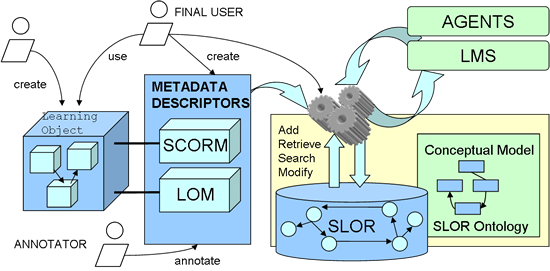 |
 |
| DOCUMENTATION |
| - Current repositoriesí shortages |
| - Towards a learning object flexible definition |
| - SLOR ontology |
| - A flexible repository: SLOR |
| FLEXIBLE METADATA STORING - ELSEM REPORT - |
| DOWNLOAD |
| WORKING GROUP |
| Further Work |
| SLOR |
-- figure 3 -- According figure 3, a learning object author “LO-CREATOR” creates a learning object, a final user can used the object that it can be located by means of repository searching capabilities. Besides a learning object author can be described a learning object in multiple formats. For example a “SCORM” metadata record with a table of contents, the types of difference resources, the navigation sequence, etcetera and on the other hand a LOM metadata record referred to the same LO can be inserted as well. Therefore SLOR can hold different metadata descriptions referred to the same object. This feature provides a new interoperability scenario; external agents can search and interoperate with learning object metadata records. SLOR prototype has been specifically designed for the metadata
learning object creation and management, with aim of integrates
and interoperates among other systems. This prototype provides new
functionalities with regard to currently repositories; it is due
to underlying ontology model and middleware tools for the semantic
web enable the execution of reasoning and inference task on metadata
records stored. The SLOR functionalities are grouped according to
scalability principle:
-- figure 4 -- There is some information that it can be linked to outward ontology concepts on SLOR basic model. Figure 5 shows an example of metadata edition where part of the information in the metadata category coverage is set to the value Spain, an instance of the TGN-Nation class in the previously-mentioned TGN ontology, which evokes the concept of Spain as a country. This scenario gives support to a deep level of search that allows making complex queries, e.g. retrieving elements of the baroque period that are situated in Spain.
-- figure 5 -- Semantic Search: This function allows searching instances of concepts in the ontology model such as retrieving all learning objects marked as “digital” or those learning objects that have an educational purpose. Several restrictions can be defined as part of the searching process. Restrictions allow filtering learning objects on different criteria (pedagogical, economic, or other), thus providing a set of results that better accomplishes the end-user needs.
-- figure 6 -- Browsing capabilities: Learning object browsing is implemented as an ontology-based seeking interface. The browser’s role in this model is to allow that any metadata category in LOM (excluding lifecycle and meta-metadata that are not related to the educational purposes of the objects) can be used as top guiding criteria. The ontology terms attached as descriptions are displayed in the browser (figure 6) , and it is finally the user who has the decision on their selection. The result of user selection is a query expression formed by a collection of ontology terms. Queries here are by default interpreted in a contextual basis, i.e. all the requirements selected by the user should be matched in the same context of the leaning object. |



